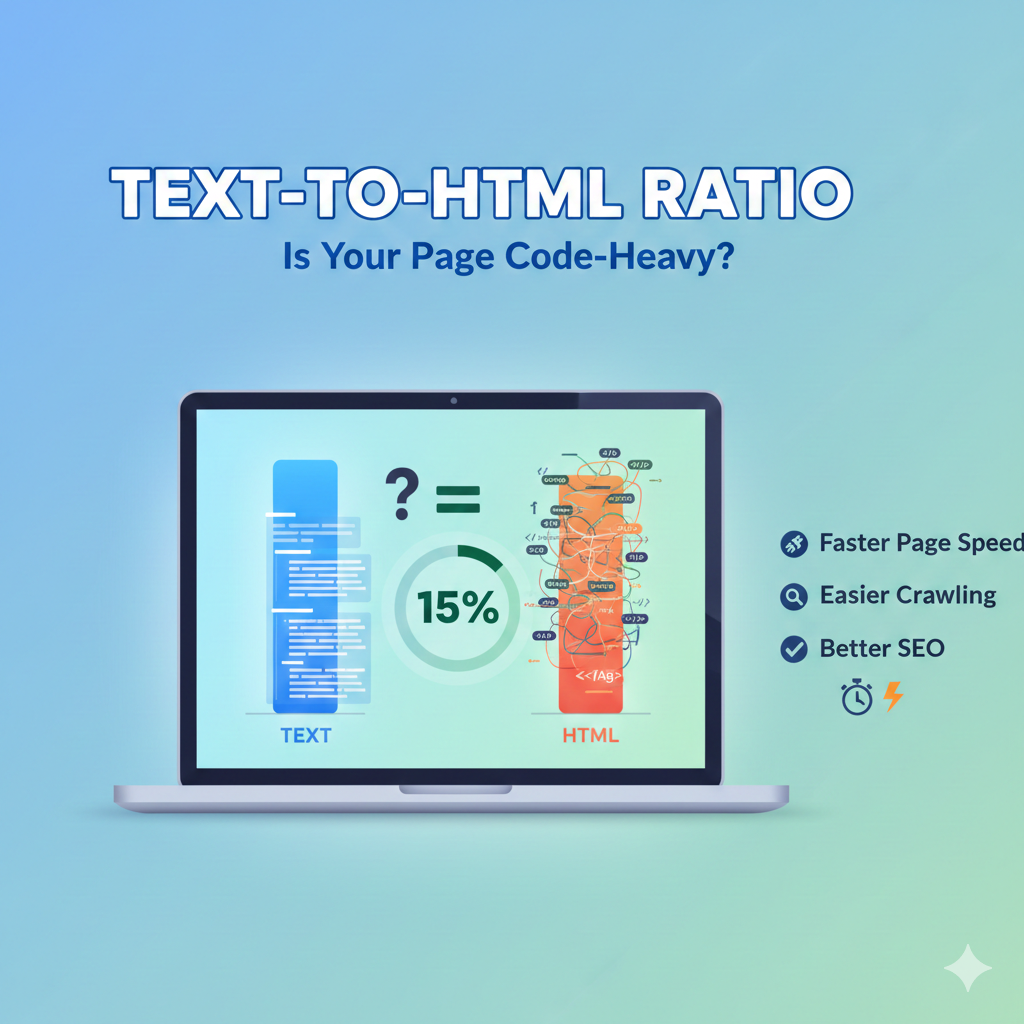The Text-to-HTML Ratio (often called the Code-to-Text Ratio) is a simple but insightful metric that compares the amount of actual, visible text content on a webpage to the total size of its HTML code. A low ratio can signal that your page is code-heavy, which often leads to slower load times and a less-than-ideal user experience.
While a Google representative has stated that this ratio is not a direct search engine ranking factor, optimizing it is still a smart SEO and user experience best practice. Why? Because a leaner code structure contributes to faster page speed and easier crawling, both of which are crucial for rankings.
📐 Understanding the Text-to-HTML Ratio Formula
Calculating the ratio is straightforward. It’s expressed as a percentage of the total HTML file size.
The Basic Calculation:

Here’s a breakdown of the components:
- Visible Text (Characters): This includes all the text a user can read: body paragraphs, headings (<h1>, <h2>, etc.), list items, and even the text within anchor tags. It excludes text within elements like <style>, <script>, and hidden HTML comments.
- Total HTML Page Size (Characters): This is the size of the entire HTML file, including all the markup (tags, attributes, white space, and the text itself).
Quick Example Calculation
Let’s imagine you’re auditing a webpage:
- Size of Visible Text: 1,500 characters
- Total Size of HTML Page: 10,000 characters
⏱️ The Fastest Ways to Calculate the Ratio
Calculating this manually is time-consuming and prone to error. For a quick, accurate assessment of whether your page is too code-heavy, you should use dedicated tools. This is the most efficient way to analyze text-to-code ratio.
1. Use an Online Text-to-HTML Ratio Checker
This is the fastest and easiest method for quick text to HTML ratio analysis.
- Simply search for a free “Text-to-HTML Ratio Analyzer” or “Code-to-Text Ratio Checker” tool online.
- Enter the URL of the page you want to analyze.
- The tool instantly crawls the page, performs the complex character count and calculation, and gives you the final percentage.
2. Manual Check (The “Developer” Way)
While not as quick as a tool, you can get a rough idea quickly:
- View Page Source: Right-click on your page and select “View Page Source” (or similar). This shows the full HTML code.
- Copy the Text: Copy all the content from the source code and paste it into a text editor (like Notepad or VS Code) to get the Total HTML Character Count.
- Isolate Visible Text: Delete all the HTML tags, scripts, and styling to leave only the visible text. Get the Visible Text Character Count.
- Divide: Perform the division and multiplication yourself to get the percentage.
This method confirms what the code actually contains but takes much longer and is primarily for technical troubleshooting.
🎯 What is a Good Text-to-HTML Ratio for Webpages?
There is no perfect number, but SEO experts generally recommend aiming for a higher text to code ratio to signal to search engines that your page is content-rich and efficient.
| Ratio Range | Interpretation | Optimization Tip |
|---|---|---|
| 0% to 10% | Very Low/Code-Heavy | This is a warning sign for excessive HTML code. Focus on code reduction and adding valuable content. |
| 10% to 25% | Acceptable for Design-Heavy Sites | Common for homepages or highly interactive sites. Strive to increase this by cutting unnecessary code. |
| 25% to 70% | Optimal Text to HTML Ratio | This range is generally considered ideal, reflecting a good balance between design elements and substantial, high-quality text. |
| 70%+ | Very High/Content-Heavy | Typical for plain-text documents or basic blogs. Ensure the text is still well-formatted for readability. |
🛠️ How to Improve a Low Text-to-HTML Ratio
A low ratio is often a symptom of bloated code, which directly impacts website load speed—a crucial ranking factor. Here’s how to optimize your text to HTML ratio for better SEO:
- Remove Unnecessary Code: Validate your HTML using tools like the W3C Validator to spot and remove redundant or invalid tags, excessive comments, and empty elements (like unnecessary <div> or <span> tags).
- Externalize Scripts and Styles: Move all your CSS (Cascading Style Sheets) and JavaScript into separate external files (
.cssand.js). This instantly reduces the size of your core HTML file. Avoid inline CSS and JavaScript where possible. - Minify Code: Use minification tools to automatically strip out all the unnecessary characters, such as white space, line breaks, and comments, from your HTML, CSS, and JavaScript files. This significantly reduces file size without affecting functionality.
- Focus on Valuable Content: The best way to increase the ratio is to add more high-quality, relevant text content. Beef up thin pages with detailed product descriptions, comprehensive guides, or longer, more insightful blog posts. This addresses the “too little text” side of the equation.
- Optimize Media: Ensure images are compressed and scaled appropriately. Using multiple, large images can necessitate more HTML code and certainly bloat the overall page size, slowing down the site.
By focusing on clean, efficient code and rich, high-value content, you’ll naturally achieve a healthy Text-to-HTML Ratio, leading to a faster website and a better user experience.


